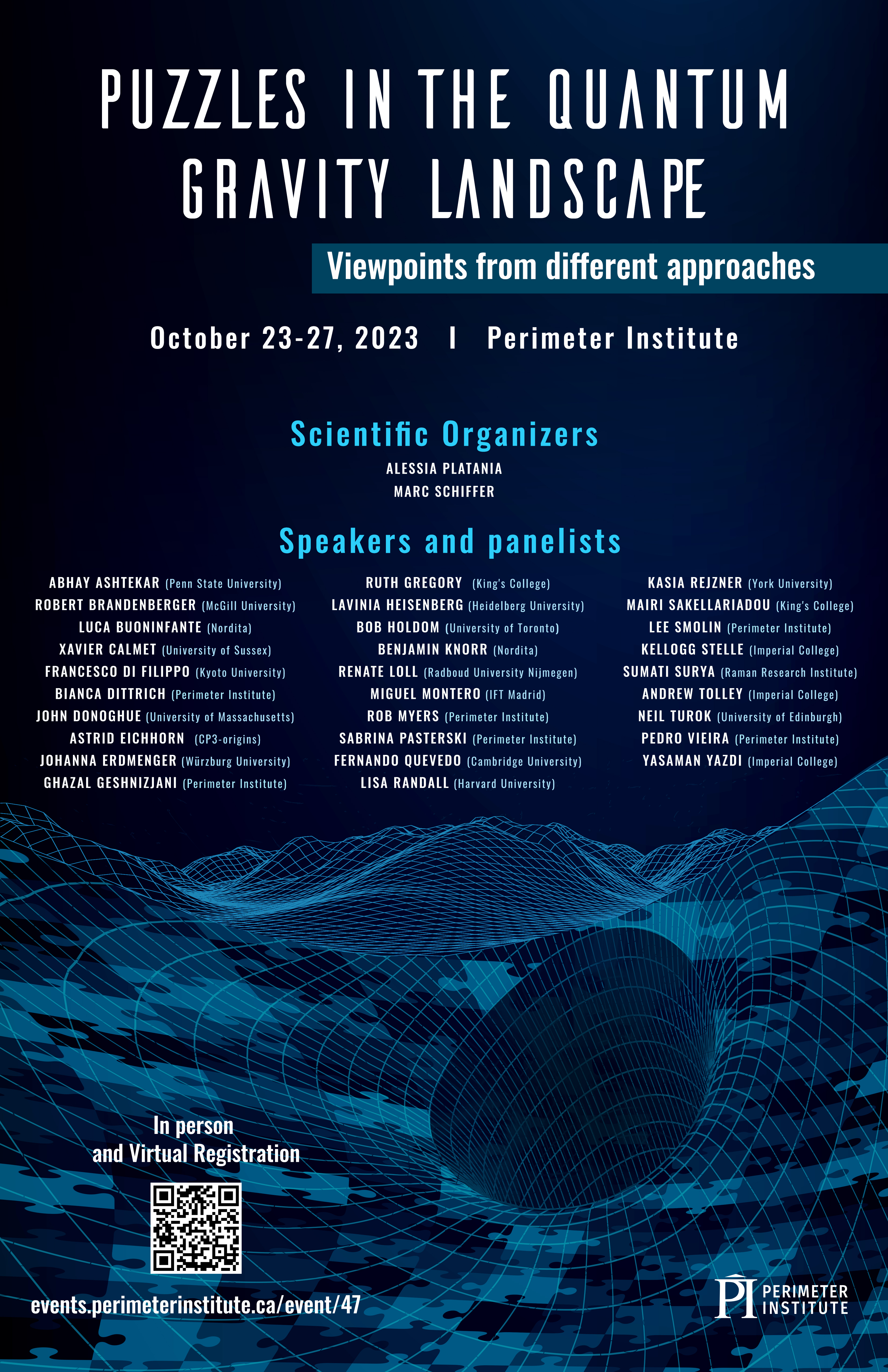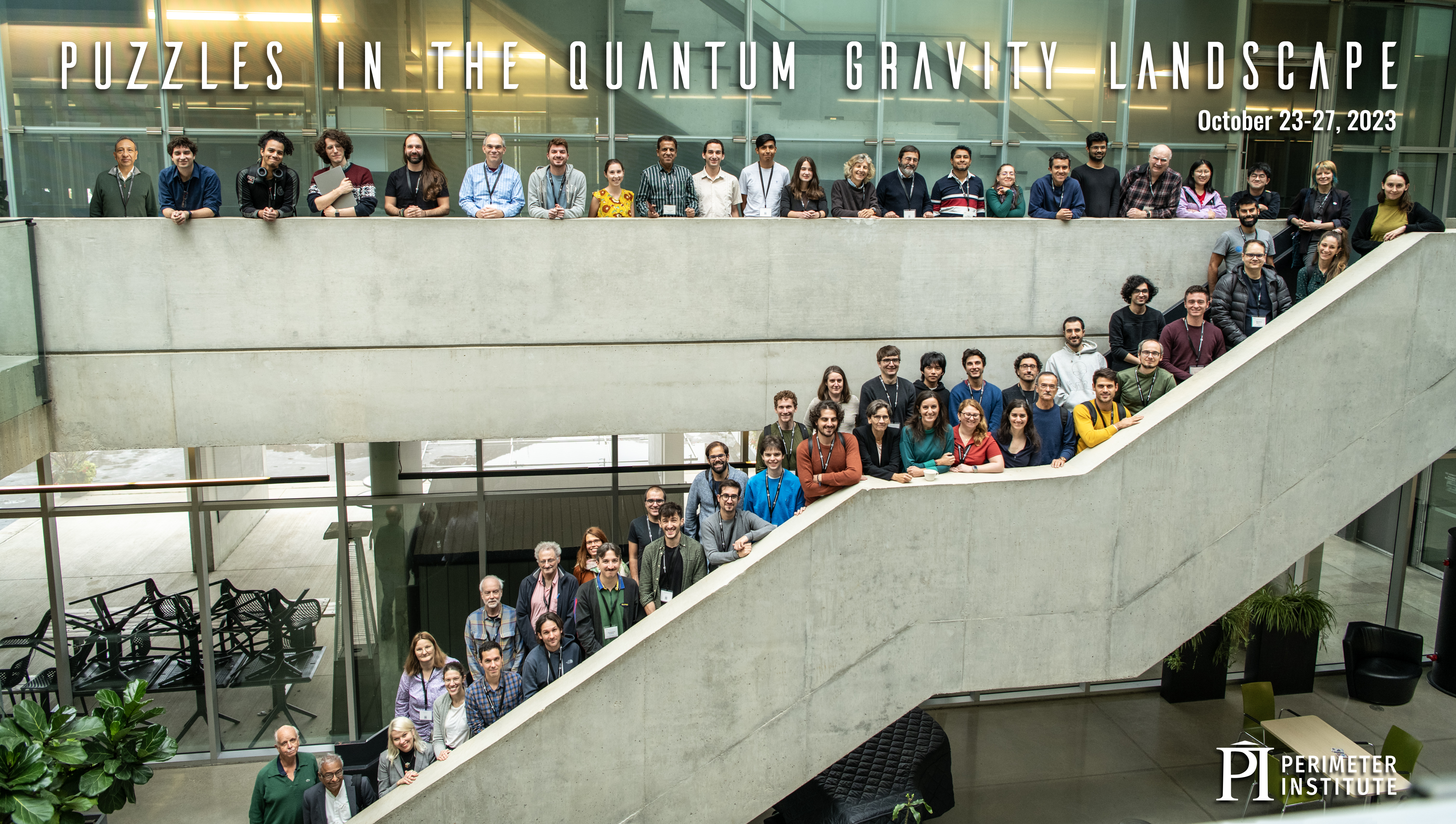Search results
Format results
-
-
Talk
-
-
-
-
-
Panel 2: Inclusion and diversity in science and technology: an initiative for equality and development.
Zélia Maria Da Costa Ludwig -
-
-
-
-
Talk
-
Twisted Holography Mini-Course - Lecture 20231214
Davide Gaiotto Perimeter Institute for Theoretical Physics
-
Twisted Holography Mini-Course - Lecture 20231130
Davide Gaiotto Perimeter Institute for Theoretical Physics
-
Twisted Holography Mini-Course - Lecture 20231123
Davide Gaiotto Perimeter Institute for Theoretical Physics
-
Twisted Holography Mini-Course - Lecture 20231116
Kevin Costello Perimeter Institute for Theoretical Physics
-
Twisted Holography Mini-Course - Lecture 20231109
Kevin Costello Perimeter Institute for Theoretical Physics
-
Twisted Holography Mini-Course - Lecture 20231102
Kevin Costello Perimeter Institute for Theoretical Physics
-
-
Talk
-
-
The rational use of resources to achieve sustainability.
Antonieta Rojas de Arias -
-
-
-
-
-
-
-
Talk
-
Lessons of the Effective Field Theory Treatment of General Relativity
John Donoghue University of Massachusetts Amherst
-
Positivity Bounds and Effective Fields Theories (A Review)
Andrew Tolley Imperial College London
-
Holography and its implications for quantum gravity - VIRTUAL
Johanna Erdmenger University of Würzburg
-
A hike through the Swamp
Miguel Mlontero IFT Madrid
-
Piecing Together a Flat Hologram
Sabrina Pasterski Perimeter Institute for Theoretical Physics
-
Open Discussion with today's speakers (Donoghue, Erdmenger, Montero, Pasterski, Tolley)
-
John Donoghue University of Massachusetts Amherst
-
Johanna Erdmenger University of Würzburg
-
Miguel Mlontero IFT Madrid
-
Sabrina Pasterski Perimeter Institute for Theoretical Physics
-
Andrew Tolley Imperial College London
-
-
Panel Discussion - Strengths and limitations of EFT (Donoghue, Knorr, Montero, Quevedo, Tolley)
-
John Donoghue University of Massachusetts Amherst
-
Miguel Mlontero IFT Madrid
-
Fernando Quevedo University of Cambridge
-
Carlo Rovelli Aix-Marseille University
-
Andrew Tolley Imperial College London
-
-
-
-
Algebraic and Combinatorial Methods in Representation Theory
The representation theory of infinite-dimensional Lie (super)algebras, Quantum groups, and Vertex algebras is an active area of research with deep connections to other areas of mathematics and to physics. The first week of this program will be a workshop consisting of four mini-courses (6 lectures each) on various themes in modern representation theory. Vertex algebras and associated varieties (Anne Moreau, Université Paris-Saclay, France) Representations of quantum affine algebras and yangians (Arun Ram, University of Melbourne, Australia) Representations of quantum superalgebras and their crystal bases (Jae-Hoon Kwon, Seoul National University, Republic of Korea) The eigenvalue problem for reductive groups (Shrawan Kumar, University of North Carolina at Chapel Hill, USA) These lectures will be aimed at graduate students, postdoctoral scholars, and researchers who wish to enter the field. The second week of this program will be on “Algebraic and Combinatorial Methods in Representa...
-
Increasing Diversity and Inclusion in Science
Increasing Diversity and Inclusion in Science
-
Algebraic and Combinatorial Methods in Representation Theory
The representation theory of infinite-dimensional Lie (super)algebras, Quantum groups, and Vertex algebras is an active area of research with deep connections to other areas of mathematics and to physics. The first week of this program will be a workshop consisting of four mini-courses (6 lectures each) on various themes in modern representation theory. Vertex algebras and associated varieties (Anne Moreau, Université Paris-Saclay, France) Representations of quantum affine algebras and yangians (Arun Ram, University of Melbourne, Australia) Representations of quantum superalgebras and their crystal bases (Jae-Hoon Kwon, Seoul National University, Republic of Korea) The eigenvalue problem for reductive groups (Shrawan Kumar, University of North Carolina at Chapel Hill, USA) These lectures will be aimed at graduate students, postdoctoral scholars, and researchers who wish to enter the field. The second week of this program will be on “Algebraic and Combinatorial Methods in Representa...
-
Active Matter and Beyond
Active matter is a novel class of driven nonequilibrium systems wherein a many-body system with an energy throughput consumes and dissipates energy at the level of the individual units. This field has grown in prominence in the last couple of decades with immense applicability in diverse areas such as granular and glassy systems, control theory, and biological systems. Many biologically crucial processes, such as the dynamics in the cellular cytoskeleton, the collective motion of cells, the progression of cancer, and the large-scale migratory behavior of bird flocks, mammal herds, ants, and fish schools have been modeled within the active matter framework.The meeting will feature research talks that will discuss recent progress in the field. Additionally, several pedagogical talks will provide a broad overview for young researchers in the country and help develop an appreciation for the significant new developments. The meeting will provide ample opportunities for young researchers to ...
-
Active Matter and Beyond
Active matter is a novel class of driven nonequilibrium systems wherein a many-body system with an energy throughput consumes and dissipates energy at the level of the individual units. This field has grown in prominence in the last couple of decades with immense applicability in diverse areas such as granular and glassy systems, control theory, and biological systems. Many biologically crucial processes, such as the dynamics in the cellular cytoskeleton, the collective motion of cells, the progression of cancer, and the large-scale migratory behavior of bird flocks, mammal herds, ants, and fish schools have been modeled within the active matter framework.The meeting will feature research talks that will discuss recent progress in the field. Additionally, several pedagogical talks will provide a broad overview for young researchers in the country and help develop an appreciation for the significant new developments. The meeting will provide ample opportunities for young researchers to ...
-
Twisted Holography Mini-Course
This mini-course will introduce twisted holography, which is holography for BPS subsectors of gauge theory and gravity. We will start by introducing the B-model topological string from the space-time perspective, before discussing branes, backreaction, and the holographic duality.
Zoom: https://pitp.zoom.us/j/98839130613?pwd=SExFK0ZVYzJ3NmJhU1RFa21PWU1qQT09
-
School on Mathematical Modeling and Governance
School on Mathematical Modeling and Governance
-
LIGO Science Workshop
The aim of the workshop is to help expand the gravitational-wave (GW) science community in India to create a large user base for the upcoming LIGO-India detector. The workshop will specifically target active researchers in areas that have potential overlap with GW science (such as astronomy & astrophysics, cosmology, gravity theory, nuclear and particle physics, etc.) and will facilitate research collaborations. The format will be that of a discussion meeting, involving a small number of overview talks and ample time for discussions, with the aim of generating new collaborations.
-
LIGO Science Workshop
The aim of the workshop is to help expand the gravitational-wave (GW) science community in India to create a large user base for the upcoming LIGO-India detector. The workshop will specifically target active researchers in areas that have potential overlap with GW science (such as astronomy & astrophysics, cosmology, gravity theory, nuclear and particle physics, etc.) and will facilitate research collaborations. The format will be that of a discussion meeting, involving a small number of overview talks and ample time for discussions, with the aim of generating new collaborations.
-
Puzzles in the Quantum Gravity Landscape: viewpoints from different approaches
Unraveling the quantum nature of gravity is one of the most pressing problems of theoretical physics. Several ideas have been put forward and resulted in a number of theories of quantum gravity. While these theories have explored different facets of the “quantum gravity landscape”, all viable approaches should ultimately make contact with observations, and answer exciting questions in cosmology and black-hole physics.
Sharing knowledge, exchanging ideas, and building a dictionary between different theories are crucial steps toward answering these questions, efficiently contrasting different theories, and ultimately reaching a deeper understanding of our Universe.
This conference will contribute to these goals by bringing together leading experts in different approaches to quantum gravity, gravitational effective field theory, black-hole physics, and cosmology. We will focus on specific puzzles in quantum gravity and their resolutions within different approaches. The conference will be highly interactive, with plenty of time to discuss common problems, understand the big picture, and develop novel connections between fields.Registration: Registration is now open, and both in-person and virtual participation is welcome. Online participants will be able to interact on an equal footing in question sessions and discussions. In-person attendance is limited and will be approved on a first-come, first-served basis. Talks are by invitation only, but in-person participants are encouraged to apply to present a poster.
Spam warning: There is an increasing number of scam agencies reaching out to conference speakers and attendees. Perimeter Institute does not use third-party agencies. We advise speakers and attendees to ignore emails and not to provide any details to anyone who is not from Perimeter Institute.
Confirmed Speakers and Panelists:
- Abhay Ashtekar (Penn State University)
- Robert Brandenberger (McGill University)
- Luca Buoninfante (Nordita)
- Xavier Calmet (University of Sussex)
- Francesco di Filippo (Kyoto University)
- Bianca Dittrich (Perimeter Institute)
- John Donoghue (University of Massachusetts)
- Astrid Eichhorn (CP3-origins)
- Johanna Erdmenger (Würzburg University)
- Ghazal Geshnizjani (Perimeter Institute)
- Ruth Gregory (King's College)
- Lavinia Heisenberg (Heidelberg University)
- Bob Holdom (University of Toronto)
- Benjamin Knorr (Nordita)
- Renate Loll (Radboud University Nijmegen)
- Miguel Montero (IFT Madrid)
- Rob Myers (Perimeter Institute)
- Sabrina Pasterski (Perimeter Institute)
- Fernando Quevedo (Cambridge University)
- Lisa Randall (Harvard University)
- Kasia Rejzner (York University)
- Mairi Sakellariadou (King's College)
- Lee Smolin (Perimeter Institute)
- Kellogg Stelle (Imperial College)
- Sumati Surya (Raman Research Institute)
- Andrew Tolley (Imperial College)
- Neil Turok (University of Edinburgh)
- Pedro Vieira (Perimeter Institute)
- Yasaman Yazdi (Imperial College)


Territorial Land Acknowledgement
Perimeter Institute acknowledges that it is situated on the traditional territory of the Anishinaabe, Haudenosaunee, and Neutral peoples.
Perimeter Institute is located on the Haldimand Tract. After the American Revolution, the tract was granted by the British to the Six Nations of the Grand River and the Mississaugas of the Credit First Nation as compensation for their role in the war and for the loss of their traditional lands in upstate New York. Of the 950,000 acres granted to the Haudenosaunee, less than 5 percent remains Six Nations land. Only 6,100 acres remain Mississaugas of the Credit land.
We thank the Anishinaabe, Haudenosaunee, and Neutral peoples for hosting us on their land.
-
Active Matter in Complex Environments
Active matter is composed of objects that convert energy from their surroundings into directed motion. Examples can be found at various length scales and involve biofilament-motor protein suspensions, swimming microorganisms, self-propelled colloids, drops, and bubbles, crawling eukaryotic cells, and flying birds, to name a few. These systems often operate in complex environments, such as soils, the ocean, or the human body, which are characterized by geometrical disorder, chemical fields, and (non-Newtonian) hydrodynamic flows. These environmental heterogeneities affect both their individual swim gait and transport behavior as well as collective phenomena, such as motility-induced phase separation and tissue formation. Major advances in experimental methods, ranging from the development of novel microscopy tools to the design of tailored microfluidic devices, together with continuously evolving data analysis methods make possible the study of active materials in controlled, complex s...
-
Active Matter in Complex Environments
Active matter is composed of objects that convert energy from their surroundings into directed motion. Examples can be found at various length scales and involve biofilament-motor protein suspensions, swimming microorganisms, self-propelled colloids, drops, and bubbles, crawling eukaryotic cells, and flying birds, to name a few. These systems often operate in complex environments, such as soils, the ocean, or the human body, which are characterized by geometrical disorder, chemical fields, and (non-Newtonian) hydrodynamic flows. These environmental heterogeneities affect both their individual swim gait and transport behavior as well as collective phenomena, such as motility-induced phase separation and tissue formation. Major advances in experimental methods, ranging from the development of novel microscopy tools to the design of tailored microfluidic devices, together with continuously evolving data analysis methods make possible the study of active materials in controlled, complex s...
